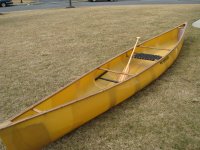I'm 6ft 1in and 210lbs...
At your height/weight I’m going to put in a good word for those “combi” canoes. Not to be paddled as a three seater tandem/solo canoe, but as a dedicated solo.
I didn’t catch your preferred paddling style, gear load or type of venue, but opening the choices to a combi canoe or a soloizable tandem presents a lot of possible choices, both new and used.
The MR Malecite is a nice big-boy solo and those aren’t exactly unicorns on Craigslist. I have a soloized kevlar Malecite and it has proven seaworthy in some fugly wind and wave.
PA Tripper’s single seat specialized composite Solo Plus is a boat I lust after (well, if I could find one used and cheap in need of repair).
The Wenonah Wilderness might be in the mix. as well as others.
I have a hard time laying out the cash for a new canoe, especially knowing that I’m likely to take it apart and put it back together to my known preferences.
A friend your size, after test paddling a dozen or so current solo canoes, opted for a composite Wilderness and ordered it from Wenonah outfitted to his specifications, including seat placement and depth, foot brace and thwart installation locations and etc.
Dropping that kind of coin on a new canoe I’d rather have everything factory installed where I want it and not be faced with drilling new holes.



